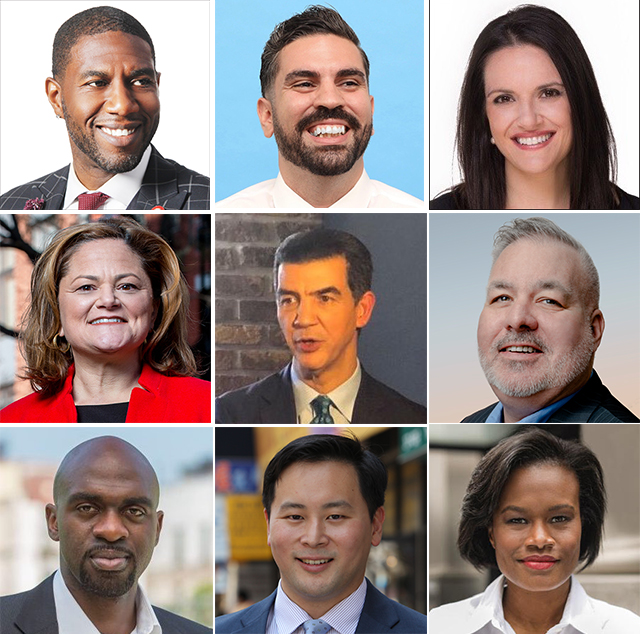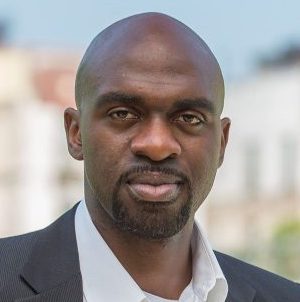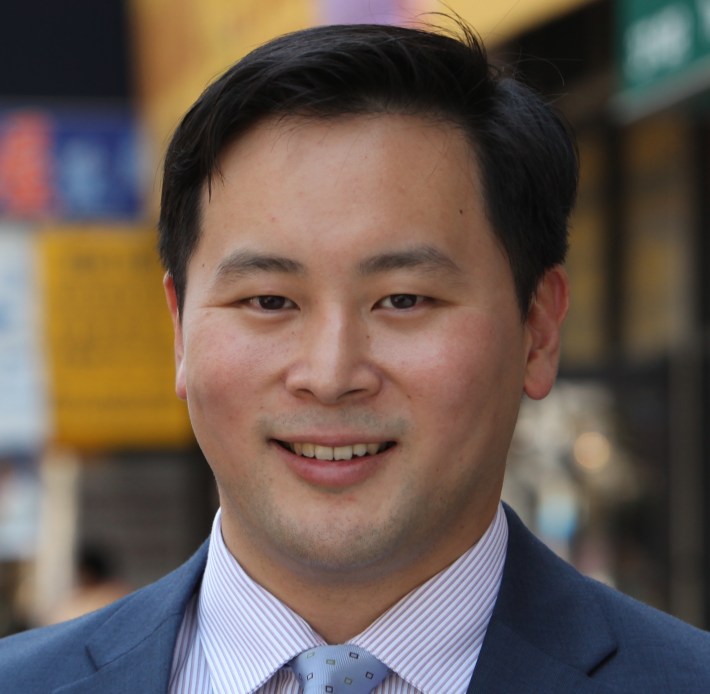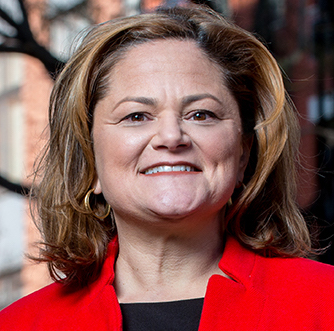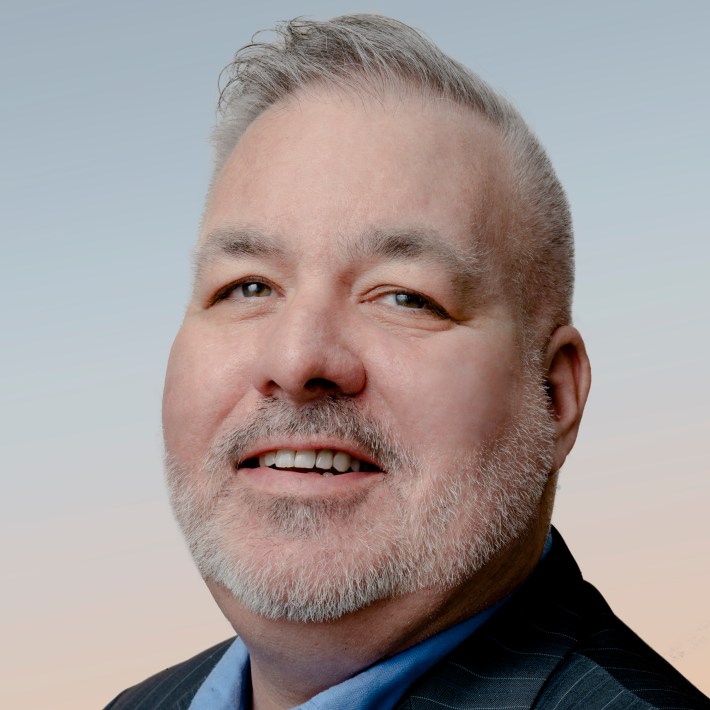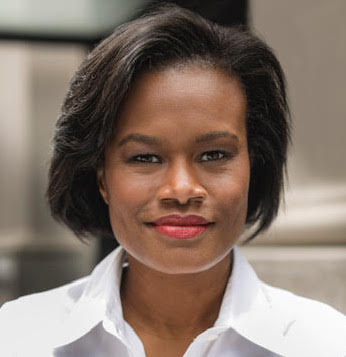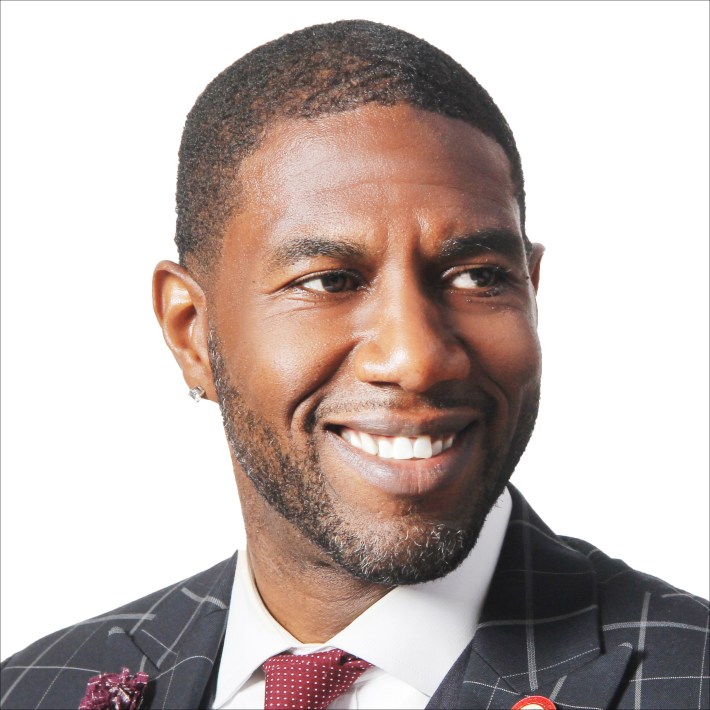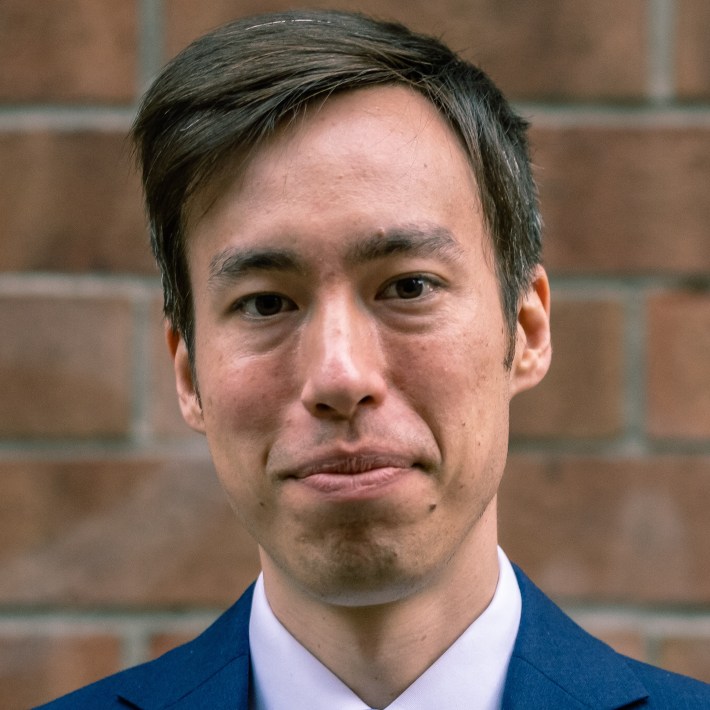It's a free-for-all for the most least important job in city government: Public Advocate!
There are 17 candidates running to fill the seat vacated by new Attorney General Letitia James (remember her leadership in the job?). The New York Times has endorsed Council Member Jumaane Williams. The Daily News picked Council Member Eric Ulrich. StreetPAC tapped former Council Speaker Melissa Mark-Viverito.
Still, it's hard to tell the players without a scorecard, so today, Streetsblog provides one for Tuesday's special election:
We asked the top candidates to discuss livable streets, safety and the future of transit — and while many answers overlap, subtle differences emerge on community board control of street redesigns, carveouts for (or expansions of!) congestion pricing, and what the public advocate should even be doing.
Here's the only public advocate questionnaire you need, with answers from Michael Blake, Rafael Espinal, Ron Kim, Nomiki Konst, Melissa Mark-Viverito, Danny O'Donnell, Ydanis Rodriguez, Dawn Smalls, Jumaane Williams and Ben Yee (Ulrich declined to participate):
1. Thinking broadly, what is the public advocate job to you?
Michael Blake: The Public Advocate is the advocate for the people. It is a watchdog on city agencies to ensure they are meeting the needs of city residents not only efficiently, but fairly and without corruption. City government must be transparent and accountable to its residents and the Public Advocate has the power to investigate systemic problems and escalate them to City Hall and the Mayor if necessary, as well as to the City Council and the public. This role is particularly necessary given the state of the City’s public housing, which is unacceptable and inexcusable, ignoring or missing the gravity of the crisis and identifying meaningful solutions. The Public Advocate should also be a check on city elected officials, especially the Mayor; however, I do not believe that check always has to come in the form of opposition.
Done right, the position can and should help refocus the Mayor’s priorities on the issues that matter most to New Yorkers. But there are times when it should manifest as opposition — like the criminal handling and cover up of lead paint in NYCHA homes and the lack of transparency and accountability in the Amazon deal. These situations require an honest, informed and principled reckoning with the Mayor and his administration. Finally, the Public Advocate should use its seat on NYCERS to advocate for jobs, transportation options, and criminal justice reform, among other things. The Public Advocate can do more to support the power of the purse strings at NYCERS to create jobs and affordable housing.
Rafael Espinal: The job of the Public Advocate is to stand up for the people and communities who feel ignored by City Hall and to hold the mayor accountable. As a City Council Member, I’ve advocated for the communities in my district that felt left out, but there are communities across the city who are being ignored and it’s up to the Public Advocate to give all of them a voice.
Transportation is an area where the Public Advocate can take a citywide view, whereas individual councillors might be more focused on their own districts.
There’s also the ability to lead with bold ideas that are good for the whole city by introducing legislation and using the bully pulpit to unite coalitions of New Yorkers and push for positive change.
Ron Kim: I want to transform the role of public advocate, and if elected I would use that role to fight to end the practice of giving away billions of dollars in corporate subsidies each year and push to reinvest that money into our communities.
We know that the role of the public advocate should be to stand up for working families and everyday New Yorkers against the powerful and wealthy interests of our city.
I believe my vision fits perfectly into this broader agenda, and fully intend to use the role to push work towards stopping corporate welfare and putting money and resources back into working families and everyday New Yorkers.
Nomiki Konst: I believe the office of the Public Advocate must be reimagined as a reform-minded, investigative, highly visible anti-corruption watchdog instead of another political stepping stone to higher office. I believe the next Public Advocate can provide a check on a political system that has become beholden to interests which are further entrenching the inequality that is slowly erasing New York and its residents.
I envision the Public Advocate to be New York's lead activist and organizer of city residents. The next Public Advocate cannot advocate for the public behind closed doors. Public engagement will perhaps be the most important tool I will wield to not only communicate my efforts, but to implement and enact them. Drawing on my background as an activist, my instincts will naturally be to organize constituents and grassroots activists, turning the Public Advocate’s office into a civic engagement hub where New Yorkers can collaborate to hold all of city government accountable.
Additionally, I will make it a top priority to reform the Public Advocate's office into a truly independent office. I will advocate for a charter revision to separate the power of the Public Advocate from politics -- no longer in the line of succession to the mayor and barring any elected official from running for the office for five years -- while also making the budget truly independent and expanded and calling for the DOI to be housed within the PA’s office, preventing political firings or appointments.
Melissa Mark-Viverito: The Public Advocate acts as a watchdog for all New Yorkers and serves as a direct link between communities and their government.
As Public Advocate, I will tell New Yorkers the truth about where our city falls short and fight for solutions to our problems, from our crumbling NYCHA system to the broken subway.
I have always used my voice to speak up and advocate for immigrants, for women, and for our LGBTQ communities — for renters, for subway riders, and for working families.
As Public Advocate, I will keep fighting for you.
Danny O'Donnell: The Public Advocate’s job is to use their platform to ensure New Yorkers from all walks of life have a voice in city government.
I believe the Public Advocate must be independent of special interests, the mayor, and the governor, and unafraid to take on the institutional failings of our city government — sexual harassment, mismanagement (NYCHA), and corruption to name a few.
I am running for this position because I want to be Public Advocate, not because I want to be mayor or seek higher office.
Ydanis Rodriguez:
The Public Advocate has the main charge to lift up the voices of New Yorkers, ensure their safety, fight for equity in all aspects, including transportation.
Dawn Smalls: In a state where corruption and scandal plague both city and state officials, New Yorkers deserve a Public Advocate who is completely independent of the political machine and who is not just using the job as a platform to run for Mayor.
As Public Advocate, I will hold the Mayor, the Governor and the City Council accountable for what New York City residents deserve — a government that works and works to serve them.
Jumaane Williams: When the role of the Public Advocate was originally created, it was intended to “rise above politics” using five primary roles, to serve as a legislator, ombudsman, Charter cop, Pension trustee and appoint individuals to a variety of positions. From day one, I would make sure to effectively serve in each of these five roles. As a Charter cop, enforcing that agencies are executing their Charter-mandated responsibilities, has been little deployed. Especially now, in a time of expanding progressive legislation and policies, there must be a force actively guaranteeing that the intentions of the people’s representatives in Council are being felt on the streets and in the lives of the people of New York. I would eagerly embrace that role as Public Advocate.
As Public Advocate, I plan to open satellite offices staffed with Deputy Public Advocates in the boroughs with the highest number of CCRB complaints. This would give members of our community a more local place to go for help related to these precincts and to give CCRB office space outside of Manhattan to send staff to meet directly with community members in their borough.
I also believe some of the top issues that New York City must address include creating safe, affordable, income targeted housing, addressing major issues with NYCHA, improving transparency and accountability in government, fixing our broken MTA, reducing gun violence and overhauling our criminal justice system. Our city needs a public advocate who can effectively be an activist elected official, fighting for working families across the five boroughs.
Ben Yee: Right now, our politics are controlled by insider interests. As a result, New Yorkers are left out of their own government, their own communities, and their own city. Functionally an office with limited power and budget, the Public Advocate has traditionally lacked the ability to do anything truly substantive for New Yorkers.
Instead it has functioned as a taxpayer-funded campaign for the next mayor. I'm running on three programs that do three simple things our city government should have been doing all along to empower the people of New York:
1. Civics For All
Civic knowledge empowers people. I've seen it firsthand teaching civics to thousands of New Yorkers who go on to successfully make their communities heard. Civics For All brings that power to every corner of New York City with workshops, classes, online guides, and a "Political 311" hotline. This will allow New Yorkers to bridge the gap between those who have specific issues and those organizing to solve them. Be in person, online or over the phone, everyone has problems which they need civics to solve. The government owes people answers.
2. Power for Communities
We need to build leverage for bottom up, community driven city planning. Right now, City Hall forces communities to react to proposals it then speeds through approval. The Public Advocate should use its resources to bring together community institutions and stakeholders to develop a shared, proactive vision of how New York should develop. Then it should use its power to support plans which have buy-in from all communities in the city. Including holding hearings on agencies which disregard them and introducing legislation to enact their decisions. If our civic institutions - like Community Boards, Education Councils and local advocates - were united in a proactive vision of New York’s future, elected officials would have to reckon with their plan. No elected wants to upset every community at once; not a mayor and certainly not any Council Member who wants to be Mayor.
3. Justice for New Yorkers focuses the litigatory work of the office on systemic bad actors who corrupt our political systems and decision-making processes. The Public Advocate's office has already done a great job calling out and suing bad landlords, but we have more bad actors in New York who need government oversight.
Justice for New Yorkers expands the focus of Public Advocate litigation to major threats like: employers who commit wage theft, a board of elections that illegally purges voters and a city that fails to enforce hard-won community concessions: like affordable housing , new schools, emergency centers, and public green spaces.
In the end, any candidate in this race must answer one key question: How can a new Public Advocate make this office relevant to solving problems and empowering communities so that city policy reflects the needs of residents?
2. What would be your top transportation policy agenda as public advocate?
Michael Blake: As Public Advocate, I will demand that the Public Advocate have a permanent seat on the MTA board so that we can immediately work to get signals repaired, find ways to improve infrastructure, have greater transportation access across the city, and bring the system into a state of good repair. Our campaign is honored to have Former Lt. Governor Dick Ravitch’s endorsement, who also previously served as MTA Chairman and provides expertise on improving out city’s transit system. As Public Advocate, I will focus on holding the Mayor and the MTA accountable to transportation equity because it’s not right that the amount of money in your bank account should determine whether or not you can get to work on time. If you earn less than $55,000 you’re more likely to have to commute over an hour to get to work. If you’re a woman you’re more likely to spend longer commuting. I also will also push the Mayor to make Fair Fares available as single rides, rather than just monthly and weekly passes which might not be accessible to everyone. Finally, I will work to get additional benches and shelters at our bus stops to make bus transit more accommodating to seniors and those with disabilities.
Rafael Espinal: I’ve proposed a game-changing plan to invest billions of dollars in the MTA, paid for by ending rebates of New York’s Stock Transfer Tax. Currently, Wall Street gets 100% of this tax rebated back to them.
By ending those rebates we could raise $11 billion a year - ten times as much as congestion pricing would raise. Fixing the subways and NYCHA housing would be the priority with that investment, and after that we could work on better public transportation in transit deserts and underserved parts of the city.
Ron Kim: Fighting to fix our crumbling public infrastructure — especially our deteriorating subways. Much of the technology we use is far too old and completely outclassed by public transportation in other major international cities.
We need to push hard for adequate funding for our transit system, which we must dramatically improve to regain commuters' confidence and trust.
We have to end the widespread practice of corporate tax giveaways and use that money to revamp our public transit system.
Nomiki Konst: We need to radically rethink our public transportation system. We must use fair congestion pricing to fund infrastructure, get ahead of autonomous vehicle impact, address transit gaps in all boroughs, and support bike programs and dedicated lanes for bikes and buses.
I support fully funding the MTA by taxing the wealthiest in our city, as well as the developers and corporations who have been incentivized to set up shop in NYC. I would not only push for full funding and a better tax structure, I would also push to expand the fair fares program and ultimately push towards elimination of fares for NYC residents, within 5 years.
Melissa Mark-Viverito: We need to fix the lifeblood of our city: our transit system. I’m running on the Fix the MTA line because our transit system is in crisis. Instead of the truth, we get excuses. Instead of finding solutions, we have a governor and mayor in a pissing match. I ride the subway every day, and I’m sick and tired of waiting for things to get better.
If elected, I will use the bully pulpit to bring more attention to the crisis and advocate for real solutions. In addition to supporting congestion pricing, I have proposed Weed for Rails, a plan to generate badly needed revenue for MTA fixes through the legalization of marijuana. Paired with congestion pricing, Weed for Rails could fund fixes and make our trains and buses run better.
Danny O'Donnell:
We must secure funding to fix the MTA.
I sponsored legislation in Albany to institute a Millionaire’s Tax, I would advocate for it in the City Council and in the legislature.
Ydanis Rodriguez: My top transportation priority will be to reduce the number of vehicles on our streets.
This will be achieved by holding the MTA accountable to complete much-needed maintenance and system update to improve reliable service; encouraging New Yorkers to choose walking or riding bikes over driving cars by improving street design and more protected bike lanes; reduce individual car ownership from 1.4 million to 1 million by 2030; and opening more streets to pedestrians with plazas and expanding initiatives such as Car Free Day.
Dawn Smalls: As Public Advocate I will work to fully fund the Fast Forward plan, advocate for a real congestion pricing system, and implement accessibility and safety improvements for all of our MTA infrastructure.
The time for squabbling over responsibility is over. Using my experience fighting bureaucracy in the Obama Administration, I will work with all stakeholders who impact the MTA, be it the Governor and State Legislature in Albany or government agencies in DC. I will work with advocates to propose a new oversight system for the MTA that is transparent and accountable to New Yorkers, not subject to backroom deals among political insiders.
I would also prioritize more and better buses. To enable buses to move more quickly through the city, we should prioritize dedicated bus lanes (with enforcement!), transit priority signaling, all door boarding, and redesigned bus routes that reflect equity and fairness.
Jumaane Williams: Fixing #CuomosMTA.
Ben Yee: My top agenda is to engage New Yorkers in sustained, bottom up decision making. Today, New York City is changing quickly but there is no holistic plan. More than anything, New York needs a to develop a comprehensive path forward so that the responses to momentary problems can serve a long-term vision of growth and sustainability that works for everyone.
Transportation is one of the most critical aspects of New York’s future and the most important thing a Public Advocate can do is ensure that the public is engaged in mapping out that plan. If undertake this task, we can dream bigger, build support for ambitious projects and do things more quickly having already addressed concerns and opposition that would arise in a piecemeal approach.
But, to answer with a specific policy proposal, it is critical that New York resolve the question of alternative transportation including bikes and e-vehicles. These modes of transit are the future of our roads. It is time to treat them that way and put as much effort into making them safe and ubiquitous as we have already done with cars.
3. Does the city build enough bike lanes? Does the city involve community boards too much or too little in that process?
Michael Blake: Only 18% of Citi Bike stations are located in ZIP codes with median household incomes below $50,000. We can do better. Citi Bike has an exclusive franchise within its operating area. We can use micro-mobility solutions to help address transit equity in New York by working with DOT and selected pilot dockless providers to find ways to make dockless bikes an integrated part of our transportation system, especially in less transit-served neighborhoods. As Public Advocate, I will work with Motivate, Citi Bike’s operator which was recently purchased by Lyft, to ensure that those funds are directed towards network expansions and improvements in our underserved communities. I am a supporter of community engagement in decision-making. I understand that some community boards have fought of bike lanes, speed bumps and other public safety measures DOT has identified. As Public Advocate, I will work to unify us to get the engagement and the solutions we need to support more and better transportation options and public safety.
Rafael Espinal: I support having more bike lanes, but they need to be planned and designed in close consultation with the community, including small businesses. There are legitimate concerns around loss of parking that need to be addressed – but also, cyclists are potential customers too. I think in the near future we will see a lot more e-bikes and e-scooters in New York and more bike lanes will help people using e-bikes be safer for themselves and for pedestrians.
We also need to enforce existing bike lanes better. When people park in bike lanes it forces people on bikes onto the footpath or into traffic, which is dangerous. I’d like to see the 311 app modified so people can report bike lane blockages.
Ron Kim: The city is trying its best to expand the number of bike lanes but it should involve the local community boards much more in the process.
Whenever dramatic changes are made to roads in an area, good or bad, it's the residents in that area most directly affected. Community boards should have greater input for any significant lane changes during the decision-making or planning process, and not just as a center for complaints or concerns after a project is completed.
Nomiki Konst: No.
We must be much more aggressive about building more bike lanes, and the city should not allow its policy goals and public interest priorities in this regard to be vetoed by those who are intransigent and out of touch with what the majority of city residents want.
Melissa Mark-Viverito: I’ve always been a staunch advocate for protected bike lanes, and I believe that we need more. Community involvement is an important part of passing legislation, and I am proud of my record of bringing stakeholders to the table to get things done.
As a Council Member, I successfully brought protected bike lanes to East Harlem, and as Speaker, I passed Vision Zero to reduce traffic, pedestrian, and cyclist deaths.
As Public Advocate, I will continue to work to bring more bike lanes to New York City, expand access to bike share programs, and get more community members involved in the process.
Danny O'Donnell:
The city needs to keep its promise when it comes to installing protected bike lines and installing bike lanes to reduce carbon emissions, improve mobility, and take pressure off of our transit system must continue to be a priority.
The local community and Community Boards must have a voice in the process, and I believe we must work together to ensure that our streets are safe for everyone.
Ydanis Rodriguez: The city does not build enough bike lanes, especially protected ones. The city should build at least 100 miles a year of protected bikes for current riders and as we encourage more New Yorkers to bike by expanding access to bike share.
Our community boards play an important part in voicing the concerns of New Yorkers. They must be a part of the conversation and educate community members on the benefits of protected bike lanes, and provide data and studies to support their stance.
Dawn Smalls: Bike lanes are an important addition to our streets. The city should focus on building protected bike lanes when they build bike lanes, not just shared lanes.
The Australian tourist who was killed this summer is a tragic example of why we need protected bike lanes.
I do believe that community boards should be involved in the process. It’s important to have community input into planning decisions and getting their buy-in helps with the implementation.
Jumaane Williams: Bicycles themselves are a necessary tool in diversifying our transportation network, as well as our goal as a City to drastically reduce harmful emissions. I support bike lanes as a way to integrate this toll into the network with safety of the rider in mind, but the community must be closely involved in the siting and planning of the lanes. All too often, lanes carry the stigma of being a sign of gentrification in communities of more color, particularly if they're imposed on the community with little to no input. Community engagement must be prioritized to safeguard the viability of bicycle lanes.
Ben Yee: The city does not build enough bike lanes and it does not involve Community Boards or community stakeholder in the process enough. Ultimately, New York is facing several interrelated challenges - transportation, affordable housing and sustainability. In the end, a robust transportation network is as important to providing access to housing stock and the volume of units. Our transportation infrastructure is also critical to our sustainability as a city as the population continues to grow, the size of roads remains the same and environmental catastrophe threatens to sink our city.
The importance of linking these issues (and others) together is because while some communities welcome bike lanes, others don’t. As a result, there is massive pushback against expansion of the bike lane program and its continued expansion breeds increasing resentment; which is bad for the future of alternative transit. Community Boards and community stakeholders should be much more involved in the city’s planning process and be brought in as partners in a holistic visioning on how to address the challenges facing our city. Facilitating alternative forms of transportation like bike lanes and e-vehicles is good and critical policy; but sometimes that can only be appreciated through the lens of other issues which institutions like Community Boards generally view as their priorities.
This is exactly what the Power for Communities plan I’m proposing is designed to do. By bringing together stakeholders across communities to engage in sustained, proactive city planning, the Public Advocate’s office can both make the important case for alternative transit while building a consensus plan for rolling out more bike lanes and community friendly rules for e-vehicles. A program like this offers us the prospect of faster, more comprehensive rollout of alternative transit solutions because, once community buy-in is built, opposition and the necessity of ad hoc implementation will fall away.
In the end, how people engage with roads is matter of rules, education and norms. As dangerous as people say bicycles are, cars are significantly more dangerous. If we can figure out how to make 2 tons of steel moving at 25 miles an hour safe, we should be able to do it for 25 pounds of aluminum.
4. What has been Mayor de Blasio's biggest mistake on transportation public policy, in your opinion?
Michael Blake: Under Mayor de Blasio’s leadership, the DOT has made major strides on safety and other fronts, but there are still many areas where we can do better, including around congestion, transit equity, and working creatively to manage freight deliveries. There has been insufficient focus on infrastructure and signals and even less success implementing the Fair Fares program. We have not, as a city, sufficiently ensured people living with disabilities have meaningful public transit options. Unemployment rates among people with disabilities is shockingly high with an estimated 1 in 9 Americans living with a disability. In our city, subways are often inaccessible, buses are too infrequent and Access-A-Ride is abysmal service. We can and must do better to connect our neighbors living with disabilities to employment opportunities by supporting their ability to travel across the city. Additionally, Fair Fare MetroCards should be available to all New Yorkers who need them, not just those who can afford $16 weekly and $60.50 monthly passes upfront. It is already too hard for too many people in this city to get around.
There has been insufficient focus on infrastructure and signals and even less success implementing the Fair Fares program.
Rafael Espinal:
The mayor should have passed congestion pricing years ago.
With City Council support he still can, rather than wait for the State to do so.
The Mayor and Council have power under NY VTL Article 39, subsection 1642, which specifically allows the city to regulate and restrict traffic including by tolling and charging.
Ron Kim: His prioritization of corporate subsidies over the concerns of everyday New Yorkers.
If he and the governor, who argue on everything, can work together to give away $3 billion without any transparency to Amazon, it shows they are prioritizing corporate interests instead of investment in people's needs, even for something as vital to all of us as fixing the subways.
Deflecting blame and passing the buck on something so essential is not an acceptable substitute for leadership.
Nomiki Konst:
I believe his biggest mistake has been a lack of commitment to a broad, strategic vision to support non-automobile transportation in the city and reduce the impact of cars, indicated by his refusal to support congestion pricing and a failure to set truly ambitious goals for bike lane and bus lane buildout.
Melissa Mark-Viverito: The mayor needs to advocate for subway riders instead of ignoring them.
He has yet to support congestion pricing, which would generate millions in revenue to fix our broken transit system. He needs to start truly advocating for congestion pricing and make sure NYC gets the majority of the funds.
His unwillingness to support this measure shows that he isn’t taking our transit crisis seriously or listening to the needs of his constituents who rely on public transit to get around.
Danny O'Donnell:
The Fair Fares rollout was an embarrassment.
Not only was the program late, but it only covered a fraction of the people included in the initial plan and applied to weekly and monthly cards. New Yorkers need leaders who will follow through on their promises, and this let many New Yorkers down.
Ydanis Rodriguez:
Not supporting congestion pricing.
The mayor has solely relied changing on street design and more strongly enforcing traffic rules such as in the Congestion Action Plan, to ineffectively address the city's severe ground transit issues.
Dawn Smalls:
I believe the biggest mistake de Blasio has made has been failing to take any responsibility for the MTA.
The mayor appoints four members to the MTA Board and could use his voice to advocate for reforms of the MTA governance board.
Jumaane Williams: I applaud the mayor for Vision Zero and the proven successful efforts to make our streets safer. Where I find a shortfall is that enforcement has often not measured up to the ambition of the policy. Too often we see non-dedicated bike lanes and SBS lanes clogged by improperly parked vehicles, frustrating the flow of traffic and harming the effectiveness of both. It's not enough to mark out space for bicyclists and rapid bus transit, the space must be kept clear for both. The biggest concern I have with the mayor’s tenure is that he often does things to the community, rather than with the community.
Ben Yee: De Blasio’s failure on transportation is the same as his failure on everything else - he seems completely incapable of making a convincing case to New Yorkers as to why the city is doing anything, and makes residents feel completely divorced from the government’s decisions. This “optics” problem shouldn’t be underestimated. In a democracy, this means that other decision makers, like legislators, are routinely encouraged to get in the Mayor’s way and stymie plans to change the city whether good or bad.
In the end, resource allocation questions are ones of political will. If you want to change allocations - like who gets to the use the street: moving cars, parked cars, bikes or pedestrians - you need buy-in from the public.
But, in terms of a policy decision, either a failure to crackdown on placard abuse or a failure to properly price parking/congestion in high traffic areas. Both of these make commuting on the street, by any means, significantly more difficult.
5. The public advocate must balance many constituencies. How would you prioritize street safety when communities sometimes oppose it?
Michael Blake: The City has made a lot of progress under Vision Zero, but our streets are not safe enough and far too many New Yorkers have been injured and killed. We must prioritize the safety of our residents, especially our children. Street safety measures need to incorporate traffic patterns, infrastructure quality, and community needs. We should have a flexible framework that priorities safety but accounts for variation in capacity.
Rafael Espinal: Safety has to be a priority. We’re talking about people's health and their lives. My experience as a councilman is that when you involve communities in complex issues from the beginning, get everyone around the table together, and work hard to find an outcome people can agree with, it works well. This is what we did with the Bushwick rezoning, which turned a proposal for 100% market rate housing into 100% affordable housing and got a new school and community center built. It would work for transportation and safety issues as well. The problem is too often politicians and special interests make the decision, and then consult the community. That’s the wrong way around.
Ron Kim: Reducing casualties and saving lives should always be a top priority for our city's leaders.
If opposition stems from mere annoyance or being inconvenienced then in those cases it's important make the case to the public that the safety of all take precedence over the exasperation of a few.
Nomiki Konst:
Despite broad public support, the issue of street safety too often lacks organized, vocal support and suffers from opposition from more organized, vocal elements who hold outsized sway on the city’s elected officials.
I believe the Public Advocate needs to serve as a counterweight by actively organizing on behalf of street safety and wielding the broad public support the issue truly has in the city.
Melissa Mark-Viverito: As Speaker, I passed the Vision Zero plan, a sweeping legislative package aimed at improving traffic safety and the safe of our streets. The package of bills included mandating more slow zones and increasing penalties on reckless drivers.
Safety is the most important priority, and I have over a decade of experience balancing the needs of different constituencies. As Public Advocate, I will continue fighting for safer streets and access to public transportation and bike lanes. Millions of New Yorkers rely on our public transit and bike lanes to get to work every day, and they deserve to be brought to the decision-making table.
Danny O'Donnell:
In the Assembly, I lowered NYC’s speed limit to 25 mph.
Some people were not happy about it, but I am proud to have played a role in making our streets safer for everyone.
You need conviction to fight for what you believe in and to be a good leader.
Ydanis Rodriguez: Street safety has been a priority for me during my tenure as chair of the Council Committee on Transportation.
Changes to improve street safety affect people in any given community differently. It is the responsibility of the Public Advocate to listen to all sides, help the public access data used to analyze the issue and solutions, and make sure that the final decision is made for the safety of New Yorkers.
Dawn Smalls:
Manhattan is a city of pedestrians. Some people drive, some people take transit, some people ride bikes; but we are all pedestrians.
I would encourage communities to weigh the importance of saving lives against other concerns that they might have (such as free street parking for private vehicles).
Jumaane Williams: I have long understood and proven an ability to build advocacy coalitions through finding common ground, and here I would employment the same approach. Street safety is a universal policy agenda, impacting every New Yorker. Communities may oppose safety measures because of an initial rejection of the inconvenience, but the gains far outweigh the costs. An effective Public Advocate can get buy-in on that point, and I have successfully done so all my career. As a person who often drives, I’m the person in place of safety respective to that of pedestrians and those on bikes.
Ben Yee: As mentioned, my top priority as Public Advocate is to engage communities in efforts to craft good policy. I do not believe that communities oppose street safety, but they do view themselves as having competing interests with policies that lead to safer streets. Through sustained and proactive engagement on these interrelated priorities, my office would work to find the root causes for the conflicts and solutions that would improve safety while still being acceptable to the community. In some cases, like speed limits and speed limit enforcement, it may be impossible to reach consensus. In these instances, we must be clear about our priorities as New Yorkers - chief among them to make New York a city where everyone can live. If a policy will save or alter lives, the facts and figures must be presented and a clear case be made for that mechanism. Only then can a community’s preferences be overridden without breaking trust that it is serving residents.
6. Do you support congestion pricing — and, if so, in what form? Whose interests should be protected?
Michael Blake: I am a strong supporter of Congestion Pricing and will work closely with the Speaker of the City Council to explore this as an option. I am a uniter as well as a fighter and will work to build relationships and work towards agreement on congestion pricing because it is important for our environmental sustainability. It is also critical that we create more public transit options for those who are currently car-dependent in the city or dependent on driving for their livelihood so that we are advancing economic opportunity for low-income communities, which is a part of our making the necessary decisions to support our long-term sustainability. We need to make sure that Immigrants are not hurt by the changes.
Rafael Espinal: Yes I do support congestion pricing, because I’ve seen the evidence that it works in cities like London. One hundred percent of the revenue must go back into the transportation system, especially to improve public transportation and active modes for people affected by congestion pricing. It’s not just about addressing traffic congestion, it’s also ultimately about reducing carbon emissions and cleaning up our air. But in New York, congestion pricing won’t provide the level of revenue that the MTA needs, which is why I’m proposing to end Wall Street tax rebates and invest that money in the MTA. This would provide ten times more revenue compared to congestion pricing, and it wouldn’t cost everyday New Yorkers a cent.
As for the details of congestion pricing, I think obviously we need to exempt emergency services vehicles and things like that, as well as people with disabilities. The system must be fair for delivery drivers, for example it could incentivize deliveries to happen outside of peak time. And we need to have high quality alternatives in place for people who drive into the city to make a living, like more park and ride facilities and better buses, trains, and ferries.
Ron Kim: I support the concept of congestion pricing as long as it does not place an undue burden on the middle class and working entrepreneurs. We already give away billions each year to corporations in the name of "economic development", when there has been no transparency and no real studies to show the effectiveness of those subsidies.
We should be using that money to fund the repairs and changes needed for our transit system, taking money from extractive multinational companies instead of our city's residents. The interests of everyday New Yorkers should always be placed first — and in this situation that means both subway or bus riders and ordinary drivers.
Nomiki Konst:
Yes.
The city needs to move forward independent of Albany with its own congestion pricing system, using city tolls to fund the MTA. Funding and supporting mass transit must be our first priority.
Melissa Mark-Viverito: Yes! I’ve been advocating for congestion pricing since 2008. I believe that the funds raised must be used to fix New York City’s transportation system, and not be spent on the governor’s pet projects.
The vast majority of people who work in New York City take public transit every day, and they are tired of being ignored. Congestion pricing will help middle class and poor New Yorkers who cannot afford to hop in a cab when the system breaks down.
As Public Advocate, I will continue fighting for working New Yorkers and make our city a better place to live and work for all.
Danny O'Donnell:
I support congestion pricing, but I believe there needs to be protections for small businesses.
We also need to conduct an environmental impact statement to ensure that no community is burdened with more traffic.
Ydanis Rodriguez:
I support congestion pricing on vehicles coming into Midtown. It has been proven successful in other cities similar to ours. It will improve the timeliness of MTA buses, generate funding for the MTA, make streets safer for cyclist and pedestrians, and help reduce our carbon emissions.
It would be a win for the city.
Dawn Smalls: I support the implementation of a fair congestion pricing plan that will create a dedicated funding stream for critical transportation infrastructure and reduce both emissions and traffic congestion.
I believe congestion pricing should be in line with the FixNYC plan, but should go further: a surcharge on vehicles entering Manhattan south of 96th Street between 6 a.m. and 8 p.m.
Jumaane Williams: I support advancing a congestion pricing plan to fund mass transit, even if it means unilaterally developing a plan on our own authority.
In the event we go forward independently, I would support using the funds generated to support mass transit that is similarly 100% within the city's control, like the NYC Ferry system.
Ben Yee: I support congestion pricing for the central business district in Lower Manhattan. A good supplemental program to better allocate the burden vehicles impose would be to appropriately price the value of street parking. Ultimately there are two, different reasons that cars create issues in congested areas - first, individuals in cars take up excessive space and excessively tax our infrastructure/environment; second, people looking for parking clog streets, take up space and drive with less attention on the road. Reducing the problem of parking (without creating more parking spaces) and reducing driving overall are two different but related objectives.
Insofar as protected interests, properly implemented congestion pricing serves the interests of all New Yorkers by making the main business district easier to navigate and safer, while also creating revenues to invest in better and more accessible mass transit. That said, there are those who will be disproportionately affected by congestion pricing because our access to our mass transit system is inequitable. As a result, the additional revenues from congestion pricing should first go towards creating, improving and subsidizing mass transit in those areas. That means expanded bus service; investment in high-speed bus lanes and enforcement; and expansion and subsidization of express busses so that there are more options and fares are aligned with regular MTA prices. It’s ridiculous that express busses cost more than twice a regular bus and senior and student discounts don’t apply - it’s an effective tax on living far from Manhattan and incentivizes car ownership. Finally, the city should ensure that the Atlantic Ticket program moves beyond the pilot phase and is fully adopted.
